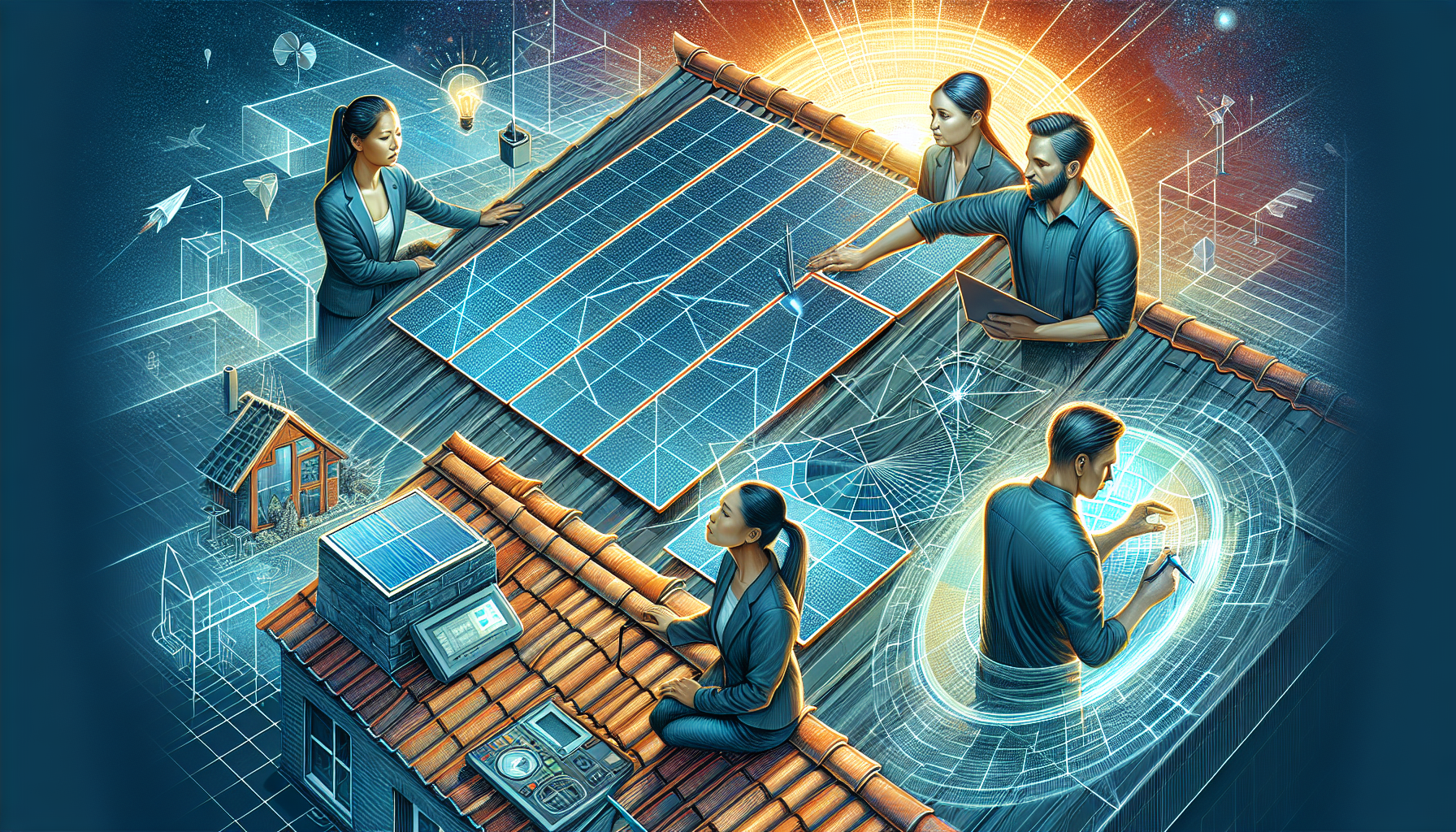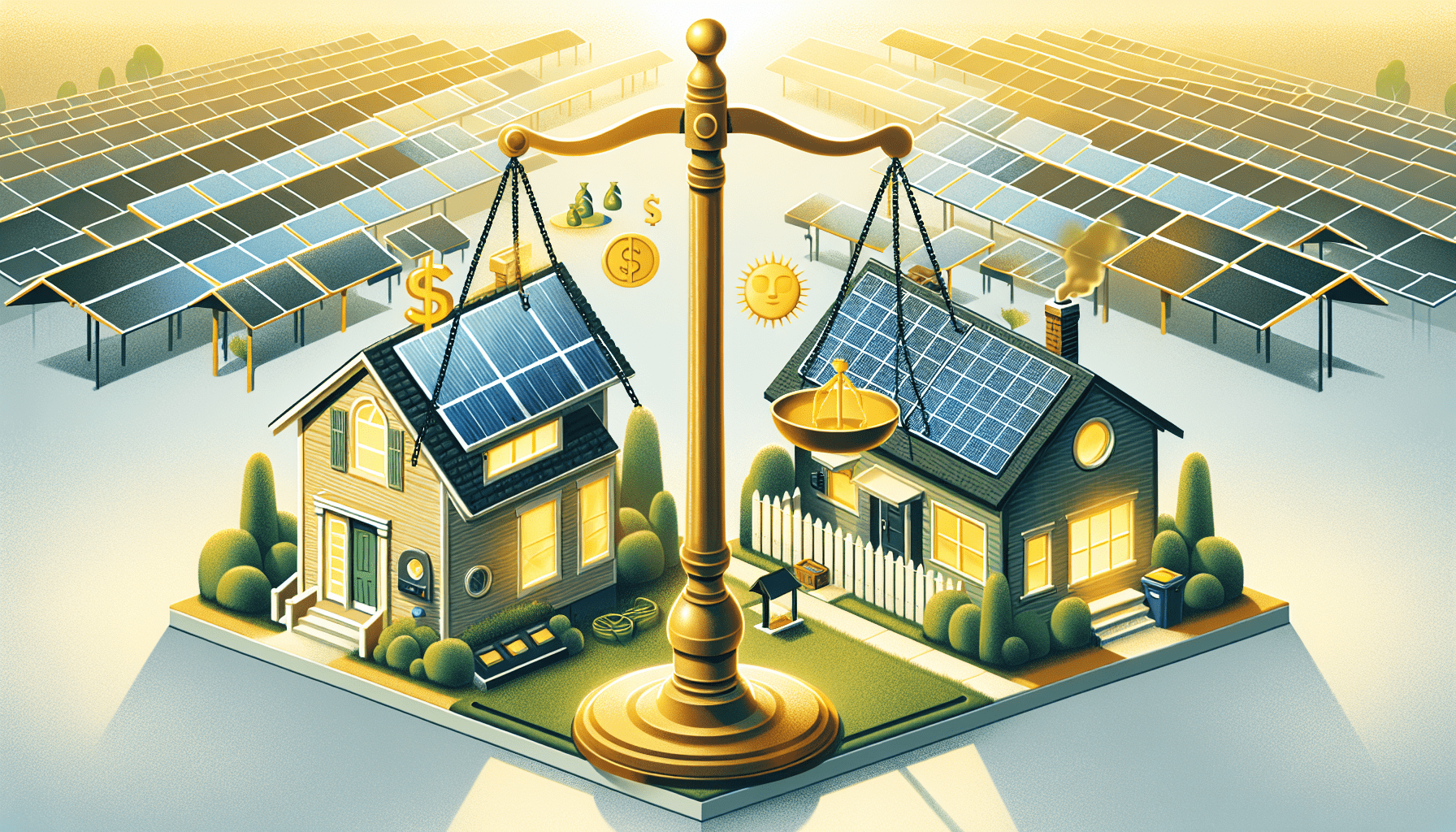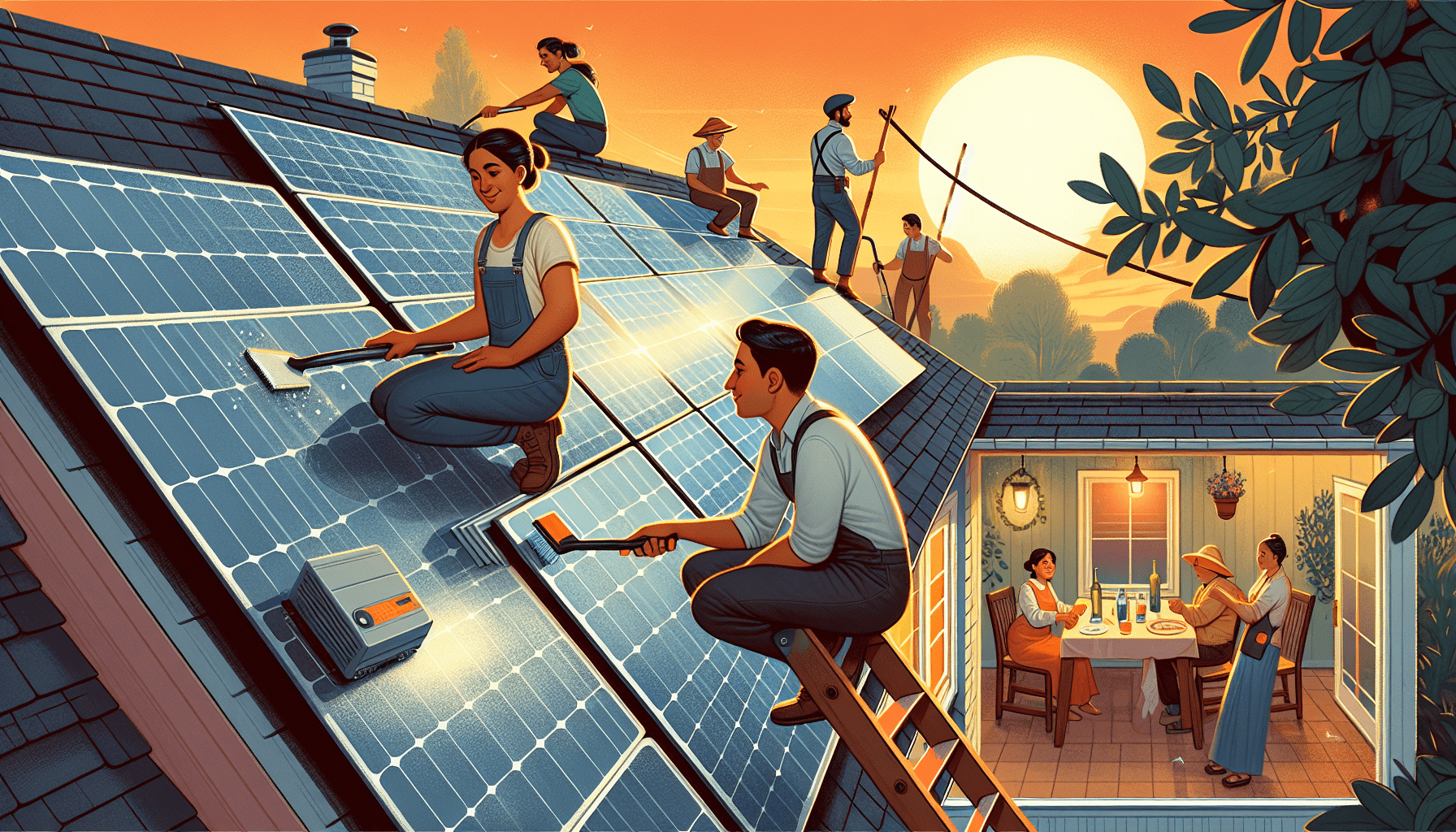If you’re contemplating the switch to solar energy, you might be evaluating community solar vs rooftop solar. Which is more cost-effective? What demands less maintenance? How will each impact your environmental footprint? This article dives into these critical questions, delivering comparisons that clarify each option’s unique advantages and helping you make the best choice for your needs.
Key Takeaways
- Rooftop solar allows individuals to generate their own electricity with solar panels installed on their property, potentially leading to significant savings on electricity bills, whereas community solar is a group-based program that requires no individual installation or management.
- Community solar offers an accessible solar energy option for those who may not have suitable conditions for rooftop installations, such as renters, people with incompatible rooftops, or those wanting to avoid upfront costs and maintenance responsibilities.
- Understanding both the financial implications, including potential tax credits and savings over time, and legal landscape, including state policies and incentives, is crucial for making an informed decision between community solar and rooftop solar energy solutions.
Exploring the Basics of Community Solar and Rooftop Solar

Harnessing solar energy primarily presents two options—community solar and rooftop solar. Both are excellent ways to tap into the abundant power of the sun, but they offer different levels of involvement, investment, and benefits. Whether you’re looking to install solar panels on your property or support renewable energy through a local solar farm, understanding the basics of both options is the first step to a brighter future.
While both community and rooftop solar offer renewable energy solutions, their methods are distinct. Community solar is shared among multiple participants, offering the benefits of solar power without the need for individual installation or management.
Rooftop solar, on the other hand, involves installing solar panels directly on your property, allowing you to generate electricity for your personal use.
Defining Community Solar
Community solar, also known as a community solar farm, is a program that enables multiple individuals to collectively reap the advantages of a centrally-located solar energy system. It allows for more widespread access to solar power among community members through community solar work. It operates on an ‘all together’ approach, with solar panels installed in a central location and the power generated shared among a community of participants. This approach ensures that more people have access to clean, renewable energy, even if they can’t install rooftop solar panels on their property.
The beauty of community solar lies in its accessibility and flexibility. Individuals can participate either by subscribing to a portion of an off-site solar array or by directly owning a part of the solar energy system. Community solar farms typically operate on a subscription-based model, which doesn’t require any upfront costs, making it accessible and beneficial for supporting local power grids. Of course, it’s critical for these programs to have consumer protection mechanisms in place to ensure subscribers receive substantial benefits from their participation.
Understanding Rooftop Solar Systems
Rooftop solar, on the other hand, is all about personal energy generation. In a rooftop solar system, solar panels are installed directly on your property, converting solar energy into electricity for your personal use. This means the power produced by your solar panels can directly offset your home’s electricity consumption, potentially saving you a substantial amount on your electricity bills.
The installation of rooftop solar panels requires careful consideration of several factors. Factors such as:
- The rooftop’s condition
- Size
- Orientation
- Sunlight exposure
Crucially determine its suitability for solar panel installation. Additionally, the space required for installing rooftop solar panels depends on the system’s size, with a 1000 watt system needing approximately 65 to 90 square feet.
And the best part? With proper maintenance, these systems can last 25 to 30 years, providing long-term benefits to homeowners. For those looking for a more integrated solution, options like a Tesla Solar Roof, which integrates photovoltaic cells into roofing material, offer an aesthetically pleasing alternative to traditional solar panels.
The Suitability Factor: Assessing Your Home for Solar Power

When deciding to go solar, several factors come into play. These can include:
- Space availability
- Roof condition
- Energy needs
- Financial capacity
- Personal preferences
- Local solar incentives
Evaluating these factors will help you determine if your home is a good candidate for a solar panel system, and whether community solar or rooftop solar is the right choice for you.
Evaluating Roof Conditions for Solar Panel Installation
Your roof plays a critical role in determining whether you can install solar panels. Evaluating the roof’s condition, size, orientation, and sunlight exposure is essential. While solar panels operate optimally on roofs with a slope between 15 to 40 degrees and facing south in the Northern Hemisphere, not all roofs are suitable for solar panel installation. Certain roofs may have an unsuitable angle and slope, which directly affect energy generation potential.
Also, the age and material of the roof are important considerations. Certain materials are more favorable, whereas older roofs might need replacement before solar panel installation. And let’s not forget about the space requirement! To host a viable solar installation, your roof must have sufficient usable surface area. All these factors need to be considered to ensure that you’re getting the most out of your rooftop solar system.
When Community Solar Becomes the Preferred Choice
Suppose your roof isn’t suitable for solar panel installation, or you’re renting your home. In these cases, community solar becomes the preferred choice. In fact, nearly half of all households and businesses are unable to host rooftop solar systems due to ownership status, unsuitable roof conditions, or high initial costs.
Low-income households and renters, who lack a suitable roof for solar panels, find hope in community solar as an alternative source of clean energy. It offers them the opportunity to access solar power without the need for a personal rooftop system. Even individuals with limited rooftop space or shaded roofs, who cannot install solar panels on their own property, may consider community solar the ideal solution. Plus, the flexibility of community solar subscriptions allows subscribers to retain their solar investment when moving within the same utility service territory.
Choosing community solar offers several benefits:
- Lower costs
- Less maintenance responsibilities
- Preserving the aesthetics of your home
- Investing in your community
- Expanding the affordability and reach of solar energy across different economic demographics
Financial Implications: Community Solar vs Rooftop Solar Panels

Beyond the environmental benefits, the decision to go solar is also a financial one. When investing in solar power, individual homeowners must critically consider initial investment and potential tax credits. Both community solar and rooftop solar offer different financial implications, and understanding these differences can help you make an informed decision.
Investment and Savings with Rooftop Solar
When it comes to rooftop solar, the initial investment can be quite significant, considering the costs of materials, planning, and labor. But don’t let this discourage you! Solar energy, being cheaper to generate than traditional forms of energy, typically equates to long-term savings on electricity bills for homeowners. In fact, the levelized cost of solar energy has become increasingly competitive, dropping significantly due to the mass production of solar modules.
A rooftop solar system is a long-term investment, and with proper maintenance, can last for 25 to 30 years. Over the lifespan of your rooftop solar system, the initial costs are offset by the savings you make on your electricity bills. And let’s not forget about the environmental benefits that come with it!
The Economic Model of Community Solar Subscription
On the other hand, subscribing to a community solar program allows individuals to invest in solar power with little to no upfront cost. Various pricing models are available, including fixed discount, escalating solar rate, or flat per-kilowatt-hour rate, and you may need to consider additional fees such as membership or early termination fees.
But there’s a silver lining. Subscribers to a community solar project:
- Pay for their share of the electricity generated
- Receive electric bill credits, leading to immediate savings on their electricity bills
- After recouping the initial investment for a share in the community solar project, subscribers continue to benefit from savings through solar bill credits for the duration of their share’s lifecycle.
Maintenance and Management: Who Takes Care of What?

Another factor to consider when choosing between community solar and rooftop solar is maintenance. Although solar panel systems are robust and designed to withstand various weather conditions, regular maintenance is necessary for optimal performance, much like any other system. The maintenance responsibilities differ between rooftop solar and community solar programs.
Responsibility for Rooftop Solar Panel System Upkeep
If you opt for rooftop solar, the responsibility for system upkeep falls on you as the homeowner. This includes ensuring functionality and addressing repairs. Before installation, a thorough assessment of the roof’s condition is critical to avoid additional costs relating to roof repairs that may necessitate the removal and reinstallation of solar panels.
Routine maintenance of rooftop solar panels generally requires annual cleaning and inspections, which can be conducted by the homeowner or through professional services, to ensure panels are free from dirt, debris, and physical obstructions. The annual cost for maintaining a rooftop solar system, including cleaning and inspection fees, typically ranges from $140 to $180.
Hassle-Free Nature of Community Solar Programs
On the other hand, community solar programs offer a hassle-free solar energy access without maintenance responsibilities. Homeowners do not need to maintain solar panels themselves when part of a community solar program. The project administrator is responsible for maintaining the photovoltaic system in a community solar program.
This takes away the worry about panel maintenance, and you get to enjoy the benefits of solar energy without any of the associated work. This is particularly advantageous for those who may not have the time or resources to dedicate to solar panel maintenance. Plus, if you move within the same utility service area, your solar benefits remain unchanged, and you can continue with the same program.
Environmental Impact and Energy Independence

At the heart of the solar energy movement is a commitment to our planet. Compared to traditional power generation methods, solar power—a clean, renewable, and abundant energy source—significantly reduces greenhouse gas emissions. Whether you choose community solar or rooftop solar, you’re contributing to a healthier environment and a more sustainable future.
Reducing Carbon Footprint with Solar Installations
Solar panels on residential properties emit considerably less carbon dioxide equivalent per kilowatt-hour compared to emissions from gas and coal electricity. The lifecycle emissions of rooftop solar energy are twelve times lower than those from natural gas and twenty times lower than from coal electricity generation.
Even though the manufacturing of solar panels does contribute to carbon emissions, these are outweighed by the clean energy generated within the initial years of operation. By adopting solar panels, you’re helping to reduce greenhouse gas emissions by decreasing the need for power produced from fossil fuels. Community solar programs contribute to reducing local greenhouse gas emissions by supplanting electricity derived from fossil fuels.
Boosting Local Grids and Global Energy Markets
Solar power installations don’t just contribute to a cleaner environment, they also support local grids. Community solar projects represent a significant portion of installed capacity, accounting for 74% in the top four states. These projects supply solar energy to local power grids, strengthening the infrastructure and boosting the local economy.
Moreover, solar power installations have a significant impact on global energy markets. They are projected to become the principal source of global electricity by 2050, attesting to their significant influence on the energy markets. By investing in solar energy, whether through community solar or rooftop solar, you’re supporting a sustainable future on a global scale.
Legal Landscape: Understanding Policies and Incentives
Adopting solar energy is not just about the technical and financial aspects. It’s also about understanding the legal landscape. Familiarizing yourself with the specific solar policies and incentives in your state is crucial, as state policies and incentives can greatly influence the adoption and economics of solar energy systems.
Navigating State Policies for Solar Power
State legislature and policies play a critical role in the adoption and implementation of solar power initiatives. State authorization is required for third parties to build and manage solar arrays, impacting the savings community solar can deliver to consumers.
To promote solar energy adoption, over half of the states with community solar have passed legislation that supports or mandates the development of these projects, making community solar available in 43 states plus the District of Columbia. For instance, Washington state exemplifies proactive solar policies, with legislation fostering equitable access to renewable energy and modernizing the energy facility site evaluation council to meet clean energy objectives.
Moreover, virtual net metering regulations enable community solar subscribers to receive bill credits in proportion to their share of a solar project’s electricity output, affecting their cost savings. This policy allows subscribers who relocate within the same utility service area to maintain their virtual net metering credits.
State-specific incentives, like Washington state’s Solar Energy System Sales Tax Incentives, further encourage solar adoption.
Financial Incentives for Solar Energy Adoption
Various financial incentives such as tax credits and rebates significantly affect the financial feasibility of solar energy adoption. For instance, federal incentives like the Federal Solar Tax Credit offer a deduction of 30% of the system cost. On the other hand, state incentives such as Washington’s Solar Energy System Sales Tax Incentive exempt solar systems from sales tax until 2029.
While federal tax credits are available to end users, state-based tax incentives might be available to community solar subscribers. However, developers usually receive the federal tax credits. The size and scope of financial incentives vary by location. For example, California’s Multifamily Affordable Solar Housing Program initiated virtual net metering to deliver solar benefits to low-income tenants, indicating how specific state policies can improve solar power access in multi-unit dwellings.
Artisan Electric’s Approach to Solar Energy
Artisan Electric brings a commitment to quality and customer satisfaction to the solar industry. As a full-service provider, we offer a comprehensive turn-key service for solar panel systems, designing and installing solar panels that meet your specific needs. As an electrical contractor with licensed journeyman electricians, we bring extensive expertise to the installation of solar panel systems and adhere to the highest standards in workmanship and service.
Serving clients across the Seattle Metropolitan Area and the Puget Sound region, we’re your trusted partner in the journey towards a cleaner, more sustainable future.
Summary
In conclusion, both community solar and rooftop solar offer unique advantages, and the choice between the two depends on your specific needs and circumstances. Whether you’re looking to install solar panels on your property or support renewable energy through a local solar farm, understanding the differences between these two options is crucial. By considering factors such as roof suitability, financial implications, maintenance responsibilities, and state policies and incentives, you can make an informed decision that not only benefits your wallet but also contributes to a healthier environment and a more sustainable future.
Frequently Asked Questions
What is the difference between community solar and rooftop solar?
The main difference between community solar and rooftop solar is that community solar allows multiple individuals to share a centrally-located solar energy system, while rooftop solar involves installing solar panels on your property for personal use. It’s an interesting way to collectively benefit from renewable energy.
What factors should I consider when deciding between community solar and rooftop solar?
When deciding between community solar and rooftop solar, consider factors such as the condition and size of your roof, your financial capacity, energy needs, and local solar incentives to make an informed choice. Make sure to weigh these factors carefully to determine the best option for your situation.
What are the financial implications of choosing community solar or rooftop solar?
Choosing community solar can offer lower upfront costs and immediate savings through solar bill credits, while rooftop solar may require a significant initial investment but can lead to long-term savings on electricity bills. Consider the long-term benefits before making a decision.
Who is responsible for maintaining the solar panel systems?
Homeowners are responsible for maintaining rooftop solar panel systems, while in a community solar program, the project administrator handles maintenance. Make sure to stay on top of maintenance tasks to keep your solar panels in top condition and maximize their efficiency.
How do solar installations contribute to the environment and energy independence?
Solar installations contribute to the environment and energy independence by providing clean, renewable energy that reduces greenhouse gas emissions and supports local grids, ultimately aiming to become the leading global electricity source by 2050. Whether you’re considering community solar or rooftop options, discover why many in Washington are opting for a Tesla Solar Roof Washington State. When deciding on solar energy, many people consider solar panels on front of house for optimal sunlight exposure.
